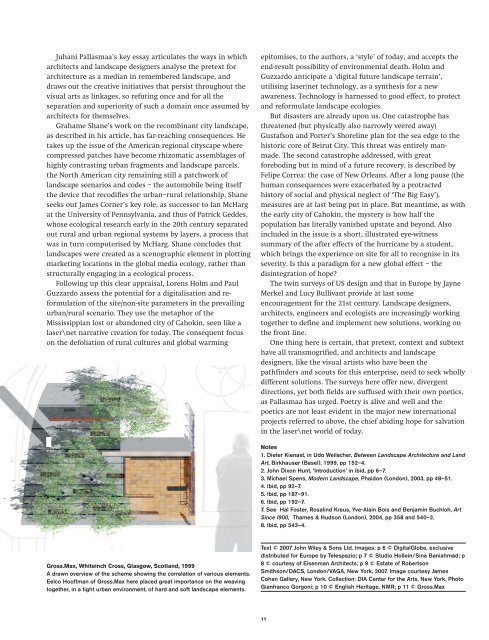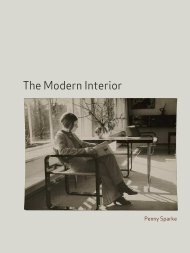Landscape Architecture: Landscape Architecture: - School of ...
Landscape Architecture: Landscape Architecture: - School of ...
Landscape Architecture: Landscape Architecture: - School of ...
- No tags were found...
You also want an ePaper? Increase the reach of your titles
YUMPU automatically turns print PDFs into web optimized ePapers that Google loves.
Juhani Pallasmaa’s key essay articulates the ways in which<br />
architects and landscape designers analyse the pretext for<br />
architecture as a median in remembered landscape, and<br />
draws out the creative initiatives that persist throughout the<br />
visual arts as linkages, so refuting once and for all the<br />
separation and superiority <strong>of</strong> such a domain once assumed by<br />
architects for themselves.<br />
Grahame Shane’s work on the recombinant city landscape,<br />
as described in his article, has far-reaching consequences. He<br />
takes up the issue <strong>of</strong> the American regional cityscape where<br />
compressed patches have become rhizomatic assemblages <strong>of</strong><br />
highly contrasting urban fragments and landscape parcels,<br />
the North American city remaining still a patchwork <strong>of</strong><br />
landscape scenarios and codes – the automobile being itself<br />
the device that recodifies the urban–rural relationship. Shane<br />
seeks out James Corner’s key role, as successor to Ian McHarg<br />
at the University <strong>of</strong> Pennsylvania, and thus <strong>of</strong> Patrick Geddes,<br />
whose ecological research early in the 20th century separated<br />
out rural and urban regional systems by layers, a process that<br />
was in turn computerised by McHarg. Shane concludes that<br />
landscapes were created as a scenographic element in plotting<br />
marketing locations in the global media ecology, rather than<br />
structurally engaging in a ecological process.<br />
Following up this clear appraisal, Lorens Holm and Paul<br />
Guzzardo assess the potential for a digitalisation and reformulation<br />
<strong>of</strong> the site/non-site parameters in the prevailing<br />
urban/rural scenario. They use the metaphor <strong>of</strong> the<br />
Mississippian lost or abandoned city <strong>of</strong> Cahokin, seen like a<br />
laser\net narrative creation for today. The consequent focus<br />
on the defoliation <strong>of</strong> rural cultures and global warming<br />
epitomises, to the authors, a ‘style’ <strong>of</strong> today, and accepts the<br />
end-result possibility <strong>of</strong> environmental death. Holm and<br />
Guzzardo anticipate a ‘digital future landscape terrain’,<br />
utilising laser/net technology, as a synthesis for a new<br />
awareness. Technology is harnessed to good effect, to protect<br />
and reformulate landscape ecologies.<br />
But disasters are already upon us. One catastrophe has<br />
threatened (but physically also narrowly veered away)<br />
Gustafson and Porter’s Shoreline plan for the sea edge to the<br />
historic core <strong>of</strong> Beirut City. This threat was entirely manmade.<br />
The second catastrophe addressed, with great<br />
foreboding but in mind <strong>of</strong> a future recovery, is described by<br />
Felipe Correa: the case <strong>of</strong> New Orleans. After a long pause (the<br />
human consequences were exacerbated by a protracted<br />
history <strong>of</strong> social and physical neglect <strong>of</strong> ‘The Big Easy’),<br />
measures are at last being put in place. But meantime, as with<br />
the early city <strong>of</strong> Cahokin, the mystery is how half the<br />
population has literally vanished upstate and beyond. Also<br />
included in the issue is a short, illustrated eye-witness<br />
summary <strong>of</strong> the after effects <strong>of</strong> the hurricane by a student,<br />
which brings the experience on site for all to recognise in its<br />
severity. Is this a paradigm for a new global effect – the<br />
disintegration <strong>of</strong> hope?<br />
The twin surveys <strong>of</strong> US design and that in Europe by Jayne<br />
Merkel and Lucy Bullivant provide at last some<br />
encouragement for the 21st century. <strong>Landscape</strong> designers,<br />
architects, engineers and ecologists are increasingly working<br />
together to define and implement new solutions, working on<br />
the front line.<br />
One thing here is certain, that pretext, context and subtext<br />
have all transmogrified, and architects and landscape<br />
designers, like the visual artists who have been the<br />
pathfinders and scouts for this enterprise, need to seek wholly<br />
different solutions. The surveys here <strong>of</strong>fer new, divergent<br />
directions, yet both fields are suffused with their own poetics,<br />
as Pallasmaa has urged. Poetry is alive and well and the<br />
poetics are not least evident in the major new international<br />
projects referred to above, the chief abiding hope for salvation<br />
in the laser\net world <strong>of</strong> today.<br />
Notes<br />
1. Dieter Kienast, in Udo Weilacher, Between <strong>Landscape</strong> <strong>Architecture</strong> and Land<br />
Art, Birkhauser (Basel), 1999, pp 152–4.<br />
2. John Dixon Hunt, ‘Introduction’ in ibid, pp 6–7.<br />
3. Michael Spens, Modern <strong>Landscape</strong>, Phaidon (London), 2003, pp 48–51.<br />
4. Ibid, pp 92–7.<br />
5. Ibid, pp 187–91.<br />
6. Ibid, pp 192–7.<br />
7. See Hal Foster, Rosalind Kraus, Yve-Alain Bois and Benjamin Buchloh, Art<br />
Since l900, Thames & Hudson (London), 2004, pp 358 and 540–2.<br />
8. Ibid, pp 543–4.<br />
Gross.Max, Whiteinch Cross, Glasgow, Scotland, 1999<br />
A drawn overview <strong>of</strong> the scheme showing the correlation <strong>of</strong> various elements.<br />
Eelco Ho<strong>of</strong>tman <strong>of</strong> Gross.Max here placed great importance on the weaving<br />
together, in a tight urban environment, <strong>of</strong> hard and s<strong>of</strong>t landscape elements.<br />
Text © 2007 John Wiley & Sons Ltd. Images: p 6 © DigitalGlobe, exclusive<br />
distributed for Europe by Telespazio; p 7 © Studio Hollein/Sina Baniahmad; p<br />
8 © courtesy <strong>of</strong> Eisenman Architects; p 9 © Estate <strong>of</strong> Robertson<br />
Smithson/DACS, London/VAGA, New York, 2007. Image courtesy James<br />
Cohan Gallery, New York. Collection: DIA Center for the Arts, New York. Photo<br />
Gianfranco Gorgoni; p 10 © English Heritage. NMR; p 11 © Gross.Max<br />
11



